 If you’re a Mac switcher from either Windows or Linux like I was a few years ago, one of the first applications you’ll want to get to know is Address Book. The sooner you import your contacts into Mac OS X’s Address Book, the sooner you’ll appreciate how a little bit of data like your contacts transform and compliment the Mac’s usability in other applications. Let’s take a look…
If you’re a Mac switcher from either Windows or Linux like I was a few years ago, one of the first applications you’ll want to get to know is Address Book. The sooner you import your contacts into Mac OS X’s Address Book, the sooner you’ll appreciate how a little bit of data like your contacts transform and compliment the Mac’s usability in other applications. Let’s take a look…
Exporting Existing Contacts from your PIM
So, let’s start with the Address Book. If you’re coming from Linux and you’re using apps like Evolution or Kontact, you’re in luck because exporting contacts should be fairly simple. Just select all your contacts, and in the File menu, select “Save as VCard…” After transferring the resulting file ending in .vcf to your Mac, open Address Book and in the File menu, select “Import vCards” and that should be it.
If you’re coming from Outlook from Windows, there is a lengthy but free way and a painless but inexpensive way. I’m going to take the easy way out and go with O2M by Little Machines. Just download it on your Windows PC, run it and follow the directions. When you’re done, you’ll too have a vCard to import into Address Book. Unless you like spending time tinkering, it’s probably more worth your time to pay the $10 to O2M and get the job done.
Lastly, if you were clever enough to use the cross-platform Thunderbird to store your contacts on whatever OS, you too can simply export selected contacts to an .ldif file, which is a format that Address Book will understand and import.
Whew, the hard part is over, now let’s have some fun!
Contact Mug Shots
One of the fun things you can do with Address Book is add photos to your contacts. It sounds trivial, but after you’ve done it (and it’s easy to do), it’s one of those features that makes you want to keep using your Mac. And it’s not because you’re going to be hanging out in your Address Book, but because the information that you store in Address Book, like a simple contact picture, is used by other applications like Mail and iChat.
You may already have images of your friends on your PC or Mac. For contacts you don’t have photos of, you can use pretty much any image you’d like. Google Image search can be very useful for people that might have an online presence, or if you’re looking to substitute your own face for George Clooney or Brad Pitt (however, the MacCast does not in any way condone the impersonation of celebrities).
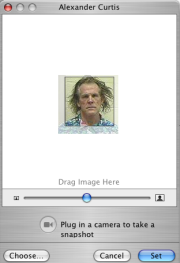
To get the image added to the individual’s contact, in Address Book, select the contact, click edit, double click the gray square to the left of the contacts name which pops up a little image re-sizer window. Either drag the image you want for that person into the window or click the “Choose…” button to find it, then move the image around so you have the part of the image within the square (which you can grow or shrink using the slider at the bottom). After you’re done, click “Set” and viola, you’ve added a lot more personality to your Address Book.
Adding more than the Default Info
You may quickly find that the default bits of information, or fields, that are listed for each contact in Address Book just don’t cut it. For instance, if a person has a web page, by default, you can’t add a URL to a contact. However, that’s easy to change. You can do it on a per-contact basis by selecting the card, then in the Card menu, select “Add Field…” and then select the field, like “URL” for adding a web page.
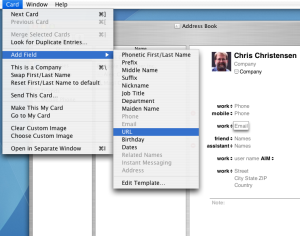
If you want to add more of the same fields already listed—say if someone has more than two phone numbers—while in edit mode, click the green “+” button by the desired field, select what the new field will be called—like “work fax”—or add your own by selecting “Custom” in the drop down list. Custom comes in very handy when you want to store a contacts relation that might not specifically be listed, like “cousin” or “milkman” or “fellow-Mac-fanatic.”

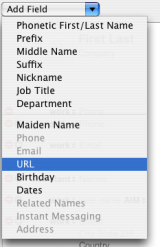
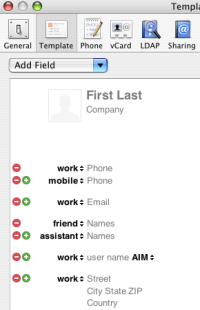
If you want to change the default fields for every contact, that’s easy to do as well. Go into Address Book’s preferences (found in the Address Book menu, or using the keyboard shortcut of Cmd-,), and select the Template icon. There you will see the default fields for each contact. To add a field, simply select the one(s) you want from the drop down “Add Field” menu. And just like above, if you want to add more of a certain field listed by default, click the green “+”, or if you want to eliminate a field by default, click the red “-“. When you close the Preferences window, you’ll find that the next contact you create will list those new fields.
Change Yourself
When you buy a new Mac, the first time you start Mac OS X, it will ask you for your name and user name, and even ask to select a user image from a bunch of fun icons pre-installed on the system. You may also note that the information you gave is stored in Address Book, in a special card called “My Card.” You can find My Card by selecting “Go to My Card” in the Card menu. It even has its own special icon in the names column and you should see a little “me” next to your image in the card itself.
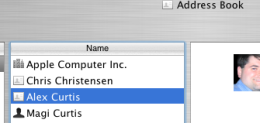
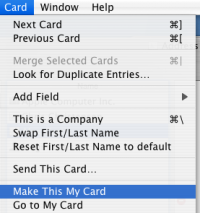

If for some reason you want to change which contact is the “My Card” in Address Book, select the new contact and in the Card menu, select “Make This My Card.”
Sorting in Groups
Another useful customization of Address Book is place contacts into groups. Not only can this come in handy for when you’re trying to find a person in Address Book itself, but it can help with email distribution lists and sorting emails into folders in Mail, picking which contacts you’d like to synchronize with your PDA or mobile phone with iSync, and creating mailing labels in Pages, just to name a few. It’s as simple as dragging and dropping.

First, make sure you’re in “view card in column” view in Address Book. From there, if you don’t have any groups already, you’ll want to create one by clicking the “+” button at the bottom of the Group column. A useful one that I use is a group for “Friends.” Then from the Name column, simply drag contacts to the name of the group one by one. If you have lots of friends (let’s all hope!), select multiple by either selecting consecutive contacts by clicking the first and then the last while holding down the shift key, or non-consecutive contacts by holding down the command/Apple key when clicking on the individual contacts, then drag them to the group name.
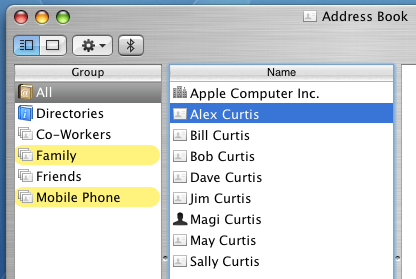
Remember, you can drop a contact into any number of groups, for different lists of people you may want to create. If you want to know which contact is in what groups, select the “All” group in the Groups column, find and click on the contact in the Name column, and then press the alt/option on your keyboard, and you should see that contact’s groups highlight.
Groups don’t only have to be made of contacts; groups can also consist of a mix of contacts and groups. Meaning, you can have Groups build off of pre-existing groups. For instance, say you have a large family and been really diligent in Address Book and made groups for your sisters, brothers, parents, grandparents, aunts, uncles, etc. But you’d like for there to be a group of all of your family. To accomplish this, just drag all those familial group onto a group called “Family,” and all of those individual contacts will pull in (even though they won’t display in Address Book)
I noted at the beginning of this post that the information you enter into Address Book will be accessible to other OS X applications. If you keep that in mind, it can help you to decide the different ways you might like to manipulate information you’ve added to contacts. For instance, knowing that I may want some contacts to synchronize to my phone and not others, I can make a “Mobile Phone” group and when the time comes, have iSync only mind those contacts. Same goes for Mail when creating distribution lists or message-sorting rules.
Searching and Smart Groups
Smart Groups are an easy way to dynamic lists or queries of information you’ve added to your contacts. This kind of list lets you do a lot of useful searches, like generate a group of friends with birthday’s in the next month, that perpetually updates. Find all the contacts that have a web page listed under their name, or an AIM address.

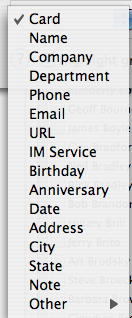
You can create these smart lists in a number of ways, but the easiest is simply to click on the button with the gear and select “New Smart Group…”. From there, you’ll get a smart group query builder, that allows you to select and combine (with the plus and minus buttons) different fields to customize your query. Once you’ve named it and clicked the “Okay” button, you’ll have your newly generated list ready to go.
Wrap-up
Address Book has a number of other great which we’ll get into at a later time. For now, hopefully all you switchers out there have a better lay of the land with Address Book. In the next Back to Basics, I’m going to talk about how you can use your Address Book to make Mail more functional.
If you have any questions, comments, or suggestions for later topics to cover, please leave a comment below.





Thanks for the tip! Just switched a few weeks ago and have already found the usefulness of the Address Book (among lots of other things in OS X). Certainly a wonderful example of automatic integration with other apps.
Congradulations Alex on being one of the first to guest blog on Maccast. Hey, since you are knowledgeble about Windows, could you or Adam explain why Quicktime is way better than WMV for video. I have a PC friend who tries to tell me WMV is better for some really dumb reason, and my only response is, they why do most of the PC vloggers use Quickime?
Adam, thanks for the guest bloggers, I love checking out the sites of the podcasts I listen to.
Excellent Alex.
Although, I already knew most of the information here. It doesn’t to read it as a review and undoubtedly will help tons to recent switchers.
Have a wonderful Sunday everyone.
Jimmy,
Thanks for the warm words of welcome! I’m really looking forward to writing for the MacCast Blog with Adam and the other new bloggers, and interacting more folks like you in the Mac community. For and by Mac geeks, right?
As for responding to your Quicktime question, I’d prefer to leave the more informed answer to someone who might know the technical specifics.
However, it may be an important distinction to note that Quicktime is both an application (which can play, record, and transcode many different formats) as well as a video format.
It might help to take a look at the Wikipedia page on Quicktime for more info:
http://en.wikipedia.org/wiki/QuickTime#QuickTime_file_format
Thanks for that very important information. I am going to shift to Linux anytime soon so this is quite a reminder for me. Thanks a lot!
Thanks for the tips. I’ve stumbled across a few address book integration delights recently, so I’m enjoying your series.
I’m quite a traveller and the one thing that drives me nuts about the smart folder function in address book is the lack of “country” > “is not set”. Why can I organise by zip code (which no-one outside of the USA has!) but not by country!
So close but so far…
Craig,
You’re right–Smart Groups are a step forward, but the queries may not be robust enough. It’s too bad.
This isn’t perfect, but here’s a temporary work around. Instead of using Country field, you could add the country name in the Notes field of the card. It’s possible you may already have the name of the country in the Note field already, so you may want to make it unique in some way–like maybe starting it with a ‘C’. Like this:
“CBrazil”
Then in the Smart Group query, select Note and have it contain “CBrazil” for that specific Group.
I wonder if you could create an Automator script to automate this process, of adding the “C + Country” to the notes field, or if there’s an Apple Script that could do it.
Anyone out there want to give Craig a hand?
Hi Alex
Thanks for a very informative article. When I switched about 2 years ago, I decided to use MS Entourage, due to ts similarity to MS Office (call that resistance to change, or what?!). I now want to get more use out of the native OSX apps Mail, Address book and iCal, and increase the distance away from anything with MS!
I’m hoping you can offer some additional tips please:
1. I like the “Birthday” integration with iCal. As a home user, I like to sync my address book contacts with my phone/pda and many of my contacts are a couple, or family who share one home email address. The fields in the address book only allow for one “birthday” entry. I have already added additional name fields for “Spouse” and “child” and I can add additional “date” fields, which I can rename for their respective birthdays. But, how do I integrate those dates with iCal? Is there another method of including additional “birthday” fields in Address Book?
2. I travel extensively for a living as an airline pilot and I used to put my monthly schedule into MS Outlook, synch it with my phone/PDA and print it out for the wife to have it available on the fridge! My problem lies with a multi-day entry: – example: If I entered a planned route ABC-DEF-XYZ-ABC, which departed my home base at 9am on 01 January, returning at 10pm on 04 January. In Outlook when I put the details as above, it would add a colour “bar”, indicating a “busy” appointment, (assigned to category “work”) from 09:00 Jan 01 to 22:00 Jan 04, and both the start and end times were visible over these dates on the PC and in the printed version.
In Entourage, it only displayed the start time and I would have to enter the end time into the “details” field (now reading “ABD-DEF-XYZ-ABC 22:00”).
iCal also only displays the strat time, BUT… the “busy” category or calender colour assigned to “work” only shows up on the day the event starts (Jan 01). The only way I can depict that I am “busy/away” for the entire period, is by manually entering both start and finish times into the “event” title/description and mark the event as “All Day”. This is just time consuming and frustrating. Apple MUST have a way of doing this. Please say they do?
I hope this all makes sense. Many thanks,
Chris
Chris,
Thanks for your comment. In one of my later posts, found here:
http://www.maccast.com/2006/10/04/back-to-basics-of-mac-os-x-part-3-leveraging-contacts-in-os-x-apps/
I linked to an app called Dates to iCal:
http://www.nhoj.co.uk/
which purports to do what you want to do with Address Book events to iCal. Please let me know if it does the job for you, I haven’t tried it. If anyone else has any experience with Dates to iCal, please let us know.
As for the second part of your question, you’re right, iCal doesn’t display this quite right, unless you check the “All Day” box. However, that’s only the case for the month display. If you look at the week display, it does it right, even without All Day checked. I don’t know if the week layout suits your purpose, but I thought I’d mention it.
Hopefully the rumored iCal updates in Mac OS X 10.5 Leopard will address these issues.
Thanks for the great job with the entire line of MacCast. My office has used Entourage for years and I have just recently switched to using Mail and AddressBook. I have had trouble with printing envelopes from addressbook such as:
-I can’t print the company and person in the address field, it is one or the other.
Any work around that you would suggest?
Thanks again.